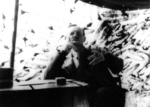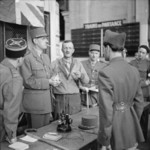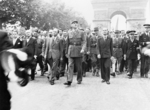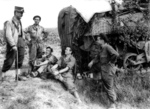Philippe Leclerc
| Surname | de Hautecloque |
| Given Name | Philippe |
| House | Hauteclocque |
| Born | 22 Nov 1902 |
| Died | 28 Nov 1947 |
| Country | France |
| Category | Military-Ground |
| Gender | Male |
Contributor: Alan Chanter
ww2dbasePhilippe François Marie de Hauteclocque was born in northern France in 1902. At the outbreak of World War II Captain Vicomte de Hauteclocque was serving as Chief of Staff in the French 4th Infantry Division. With the French capitulation, de Hauteclocque, who had twice escaped from German captivity moved his family to Bordeaux; then set off to join General Charles de Gaulle in London, England, United Kingdom. In England he wisely chose to change his name to Jacques Philippe Leclerc in order to protect his family, who were still in France, from possible reprisals.
ww2dbaseExploits in Africa
ww2dbaseWithin weeks, Leclerc was sent by de Gaulle to become the Free French Military Governor in French Equatorial Africa. His first military exploit in Africa occurred in early 1941, when he led a small force of Free French and British Army Long Range Desert Group troops on a daring raid against the Italian garrison at the remote oasis of Koufra in south-eastern Cyrenaica, Libya. This was the first victory for Free French arms, although ultimately he was compelled to retire when, further north, General Archibald Wavell's offensive fell back into Egypt. Then in the autumn of 1942 he collected together a force of 555 Frenchmen and 2,713 colonial and African troops and led them on a 1,500 mile march across the Sahara from Fort Lamy in French Equatorial Africa to join with Bernard Montgomery's 8th Army at Tripoli, Libya. Welcomed by Montgomery and Harold Alexander, Freddie de Guingand, Montgomery's Chief-of–Staff, recorded, Montgomery shook the emaciated Frenchman's hand and later told Guingand, "I can make use of that chap." Leclerc's force were soon in action at the Mareth line - distinguishing themselves by destroying a strong German armoured reconnaissance force on 10 Mar 1943, at Ksar Rhilane, fifty miles south-west of Modenine, Tunisia, leaving a dozen enemy armoured cars, guns and lorries burning in the desert.
ww2dbaseThe talents of this remarkable French officer soon came to the attention of General Dwight Eisenhower who had him posted to England to raise and train the French Second Armoured Division. The Division, equipped by the Americans, recruited many of its men from experienced Free French veterans who had fought in North Africa. Indeed it was as a brilliant divisional commander that Leclerc would now start to make his name.
ww2dbaseNormandy to Paris
ww2dbaseThe French Second Armoured Division landed at Utah Beach on the Normandy coast of France on 1 Aug 1944, attached to George Patton's XV Corps (Major General Wade M. Haislip). XV Corps headed for Le Mans before striking north via Alencon in the direction of Argentan (driving seventy miles in twenty-four hours). XV Corps, temporarily attached to Omar Bradley's First Army were then ordered to stand fast and prepare for operations in another direction. This order left Haislip in a vulnerable position with a 20 mile wide open flank between Argentan and the rest of the US First Army at Mayenne and would seriously delay the closing of the Falaise Gap for several valuable days. At around 2000 hours on 19 Aug 1944, Second Lieutenant Karez of the Polish 10th Dragoons, pushing southwards through the burning streets of Chambois, toward the River Dives made the first link-up with the Free French. Although the Falaise Gap was not entirely sealed, from then on only small groups of Germans would be able to escape from the Allied trap. Their last stragglers passing through the lines of 2 SS Panzer Corps at 1600 on 21 Aug 1944.
ww2dbaseDe Gaulle, meanwhile, was anxious that the liberation of Paris should be an entirely French affair but had failed to convince Eisenhower who preferred a bypass operation to isolate the city. When the Parisian resistance rose up in revolt, de Gaulle, seriously concerned less the uprising might be wiped out, went to Eisenhower to demand that Leclerc's division leave for Paris without delay. Leclerc, still at Argentan, 100 miles from Paris, on his own initiative hastily formed a detachment of 150 men, ten tanks and ten other armoured vehicles and ordered Lieutenant-Colonel Jacques de Guillebon to take them to Paris. Leclerc's unauthorised action almost floundered when units of the US V Corps reported Guillebon's presence near Rambouillet, well outside the area allotted to the Division. Leonard Gerow, the V Corps commander, who disliked Leclerc intensely, demanded Guillebon's instant recall but he was overruled by the Supreme Commander who finally agreed to allow the remainder the Leclerc's Division to set off for French capital.
ww2dbaseIn three columns the division marched to Paris meeting on their way with heavy resistance from German batteries and 88-millimeter guns which cost them some 71 men killed and 225 wounded, together with 35 tanks, 6 self-propelled guns and 111 assorted vehicles put out of action. Further delays were caused by a jubilant civilian population frequently stopping the vehicles to present the soldiers with flowers, drinks, kisses and urgent requests for news about their loved ones. Finally, to the sound of chiming church bells, three light tanks, and a small number of other armoured vehicles entered Paris through the Porte Gentily. They crossed the Seine at the Pont d'Austerlitz and at 2230 hours, pulled up outside the Hotel de Ville to be greeted by cheering, welcoming crowds of Parisians. Next morning Leclerc and the remainder of the division entered Paris in force, and soon the tricolore streamed out from the top of the Eiffel Tower and, a while later, from the Arc de Triomphe.
ww2dbaseDuring that afternoon, at the Prefecture, Dietrich von Choltitz, the German commandant in Paris since 7 Aug 1944, surrendered to General Leclerc. Resistance leader Colonel Roi-Tanguy's frustration at a lost Communist cause was complete when Leclerc refused to allow him to sign the surrender document - announcing that as the highest ranking officer present, his signature would serve to represent all. On the following afternoon, even while Resistance fighters were clearing the last snipers and collaborators from the side streets, de Gaulle, having arrived, held a dramatic victory parade down the Champ Elysees.
ww2dbaseStrasbourg and the Colmar Pocket
ww2dbaseOn 15 Aug 1944, the US Seventh Army together with troops of the French II Corps landed on the coast of Provence in southern France. At 0900 hours on 12 Sep 1944, scouts from the Leclerc's 2nd Armoured Division, now back with the Third Army, met the French II Corps moving north from Dijon, effectively linking the Allied forces from Normandy with those from the South of France.
ww2dbaseOn 29 Sep 1944, the US XV Corps, including Leclerc's division, was transferred from the Third Army to General Alexander Patch's Seventh Army.
ww2dbaseThree months later, Leclerc's division made an unauthorised dash through the Vosges to become, on 23 Nov 1944, the first Allied troops to enter Strasbourg, France. They found the city had been thoroughly looted by the SS before they had withdrawn, and many German soldiers, left with orders only to fight to the last round, simply threw away most of their ammunition and claimed to have run out simply to justify their surrender. Terrified Nazi officials including the city mayor, deputy mayor and Landgerichtspräsident (Chief Judge who had signed so any death warrants during the occupation) had also fled across the Rhine, fearful of being tried or lynched by a vengeful population.
ww2dbaseA few days later, General Jacob Devers ordered the 2nd Armoured to join the First French Army guarding the Colmar Pocket. Leclerc, who was admired and liked by senior American officers, utterly refused, stating that he would not fight with General Jean de Lattre de Tassighny and the rest of those officers who had previously loyally served Marshal Philippe Pétain until the tide of the war had changed. Devers recorded later: "I just couldn't get Leclerc to join the French 1st Army - so I sent him back" (to Patch's US Seventh Army).
ww2dbaseDevers eventually persuaded Leclerc to join General Joseph de Goislard de Monsabert's French 2nd Corps for a drive into the northern part of the Colmar Pocket. Leclerc was not happy with the idea as he regarded Monsabert as little better than a turncoat but, nonetheless, was converted when Devers promised that the 2nd Armoured would ultimately return to American control. Zero hour was set for 0730 hours on 23 Jan 1945 with Leclerc's 2nd Armoured tasked with supporting the advances of the 1st Free French and 3rd US Infantry Divisions. The offensive would not be as easy as Dever's expected. The terrain, consisting of a network of small rivers and canals with numerous woods, was hostile to the attacker, and was fiercely held by determined soldiers of the German Nineteenth Army. The Pocket had been liberally filled with numerous blockhouses, booby traps and deadly minefields (many containing the new Bakelite mine which did not register on mine-detectors) and many villages had been converted into strongpoints. The Arctic temperatures of Jan 1945 favoured the defenders too, with frequent blizzards covering the land in a blanket of deep snow drifts that seriously hindered vehicle movement.
ww2dbaseOn 28 Jan 1945, Combat Command C, whose Foreign Legion infantry escort, having to clear mines along the way, had fallen well behind the French tanks, attempted to enter, across a narrow bridge, the village of Grussenheim. German heavy tank destroyers took a heavy toll of the French armoured fighting vehicles. In the day-long battle Leclerc's tankers would suffer two hundred and seven casualties and the Legionnaires another one hundred and eighty more. The devastated Combat Command had just two tanks remaining at the end of the days fighting. Fortunately, for the 2nd Armoured, the German defenders, of the 198th Infantry Division, were then ordered back across the Rhine leaving just a small holding force behind to delay the French advance.
ww2dbaseWhen ordered to resume the attack on 29 Jan 1945 Leclerc refused to do so without the support of two more infantry battalions. Monsabert replied that fresh infantry were simply not available (largely because his US 3rd Infantry had been transferred to the 21st Corps during the night) and Leclerc would have to attack with what he had. The attack was, for the moment, effectively stalled. Then, on the afternoon of 30 Jan 1945 came evident signs of a German withdrawal which moved de Lattre de Tassighny to urge a reluctant Leclerc to press on to the Rhine. The brutal battle in the Colmar Pocket would ultimately cost the French First Army more than 10,000 dead and wounded before it was finally culminated on 6 Feb 1945.
ww2dbaseA period of inaction now followed. In early Mar 1945 SHAEF informed 6TH Army Group that the French First Army's future role would be only to hold the west bank of the Rhine, while Bradley and Montgomery's Army Groups in the north would press on into Germany. This did not prevent French units from actually crossing the river during the night of 31 Mar 1945, and during Apr 1945, despite being ordered to provide just a rear-guard to the American Seventh Army, were actively involved in clearing the Black Forest and then racing on to capture Stuttgart – overcoming last ditch fanatical SS units, who still stubbornly refused to surrender in the dying days of Hitler's Third Reich. For a time in 1945 Leclerc was governor of Strasburg. His promise, made at the oasis of Kufra, not to disarm until the tricolore once more flew above Strasbourg Cathedral had been fulfilled.
ww2dbasePostwar
ww2dbaseWith the war over the French were eager to recover their pre-war colonies. In late 1945 General de Gaulle sent Leclerc to become the Commander-in-Chief in French Indo-China. There Leclerc's stern measures against the Vietnam insurgents would excite much criticism within left wing quarters. General Leclerc lived scarcely two years after the war. In 1947 he was killed in a mysterious air crash in North Africa. Some said it was the work of the communists who hated him. But nothing could be proved, for his body was never recovered.
ww2dbaseSources:
Charles Whiting: Operation Northwind (Grafton Books, 1987)
Edward Davison & Dale Manning: World War Two-The Personalities (Arms and Armour Press, 1997)
Henry Maule: Caen 1944 (Coronet Books, 1980)
James Holland: Together We Stand (Harper Collins Publishers, 2006)
Antony Beevor: Ardennes 1944 (Penguin Books, 2016 pp74)
Everyman's Encyclopædia Volume 7 (Fabbri & Partners Ltd, 1973)
Wikipedia - "Philippe Leclerc" & "Battle of Kufra"
Major General Hubert Essame: "Corridor of Death "
Brenda Ralph Lewis: "The Liberation of Paris"
Brenda Ralph Lewis: "Operation Dragoon"
Peter J Banyard: "Colmar 1945"
Last Major Revision: Aug 2019
Philippe Leclerc Interactive Map
Photographs
 |  |  |  |
Philippe Leclerc Timeline
| 22 Nov 1902 | Philippe de Hautecloque was born in Belloy-Saint-Léonard, Picardie, France. |
| 9 Sep 1924 | Philippe Leclerc was promoted to the rank of sub-lieutenant. |
| 26 Oct 1924 | Philippe Leclerc was promoted to the rank of lieutenant. |
| 25 Dec 1934 | Philippe Leclerc was promoted to the rank of captain. |
| 31 Jul 1940 | Philippe Leclerc was promoted to the rank of major (Chef d'escadron). |
| 27 Aug 1940 | Philippe Leclerc was promoted to the rank of lieutenant colonel. |
| 2 Mar 1941 | At Kufra, Libya, Free French Major Philippe Leclerc pledged not to lay down his weapons until the French flag once again flew over the cathedral at Strasbourg, France. |
| 1 Jun 1941 | Philippe Leclerc was promoted to the rank of colonel. |
| 10 Aug 1941 | Philippe Leclerc was promoted to the war time rank of brigadier general. |
| 14 Apr 1942 | Philippe Leclerc was promoted to the rank of brigade general. |
| 25 May 1943 | Philippe Leclerc was promoted to the rank of division general. |
| 1 Aug 1944 | General Philippe Leclerc's 2nd French Division landed on "Utah" beach, Normandie, France. |
| 13 Nov 1944 | General Philippe LeClerc's Free French troops attacked to the Upper Rhine out of Alsace, France. |
| 25 May 1945 | Philippe Leclerc was promoted to the rank of corps general. |
| 17 Aug 1945 | Charles de Gaulle appointed General Philippe Leclerc as commander of French forces in the Far East, tasked with reasserting French control in French Indochina. |
| 5 Oct 1945 | General Philippe Leclerc arrived at Tan Son Nhut Airfield in Saigon, Cochinchina, French Indochina to take command of all French forces in the region. |
| 10 Oct 1945 | Major General Douglas Gracey ordered his troops to march into the northern suburbs of Saigon, Cochinchina, French Indochina as a response to Viet Minh attacks on the previous night. Later in the day, Gracey and General Philippe Leclerc traveled to Singapore to attend an Allied conference; Gracey would receive additional reinforcements from Louis Mountbatten during the meeting, but he was also reminded that the preferred method for the situation in Saigon was to de-escalate via negotiations, not by force. |
| 11 Oct 1945 | British Lieutenant Colonel E. D. Murray traveled from Phnom Penh, Cambodia to Saigon, Cochinchina. Murray proposed the arrest of Prime Minister Son Ngoc Thanh of Cambodia, and the notion was supported by French General Philippe Leclerc. |
| 15 Oct 1945 | The British Supreme Allied Commander in Cambodia, Lieutenant Colonel E. D. Murray arranged for a meeting with Cambodian Prime Minister Son Ngoc Thanh in the afternoon in Phnom Penh. It was an ambush. At Murray's headquarters, he and French General Philippe Leclerc oversaw the arrest of Thanh for being too nationalist for British and French comfort. Thanh was handled roughly and was not told why he was being detained during the process. Thanh's chauffeur, witnessing his employer being taken away by force, drove off and warned Thanh's colleagues who might also be on the British-French list of targets. Thanh and Leclerc would board a flight for Saigon, Cochinchina before the end of the day. |
| 14 Jul 1946 | Philippe Leclerc was promoted to the rank of army general. |
| 28 Nov 1947 | Philippe Leclerc was killed when the B-25 aircraft he traveled aboard crashed near Colomb-Béchar, South Territory, French Algeria. |
| 23 Aug 1952 | Philippe Leclerc was posthumously promoted to the rank of marshal. |
Please consider supporting us on Patreon. Even $1 per month will go a long way! Thank you. Please help us spread the word: Stay updated with WW2DB: |

» Battle of Kufra
» Normandy Campaign, Phase 2
» Liberation of Paris
» Advance to the Rhine
» Japan's Surrender
- » 1,177 biographies
- » 337 events
- » 44,933 timeline entries
- » 1,245 ships
- » 350 aircraft models
- » 207 vehicle models
- » 376 weapon models
- » 123 historical documents
- » 261 facilities
- » 470 book reviews
- » 28,473 photos
- » 365 maps
General Douglas MacArthur at Leyte, 17 Oct 1944
Please consider supporting us on Patreon. Even $1 a month will go a long way. Thank you!
Or, please support us by purchasing some WW2DB merchandise at TeeSpring, Thank you!